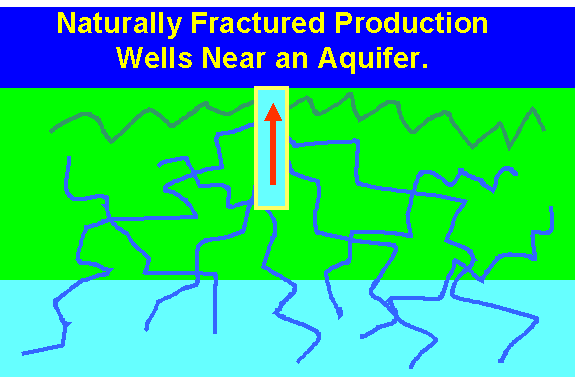Natural Fracture System Leading to an Aquifer
Problem 7 in Table 1

Several operators reported impressive (but often short-lived) results from polymer and gel treatments in production wells in the Arbuckle, Ellenberger, and Madison formations.4,53,54 These treatments were applied to reduce excessive water production emanating via natural fractures from underlying aquifers that provided strong water drives.
Phillips applied 37 treatments in Arbuckle formations using eight different organic polymer and polymer-crosslinker combinations.53 In their treatments, the average incremental recovery was 1.9 STB/lb polymer, with a range from -1 to 13 STB/lb. The average time for the well to return to the pre-treatment WOR, and oil production rate was 12 months, with a range from 2 to 43 months. The treatments typically reduced total fluid productivity by a factor of two. Interestingly, Phillips found that the incremental oil recovery, treatment lifetime, and WOR reduction did not correlate with the mass of polymer injected (390 to 1,400 lbs/well), type of polymer or gel treatment (8 types used), productivity reduction induced by the treatment (1 to 5), structural position of the completion, completion type, fluid level before the treatment, or the Arbuckle reservoir.53 (Treatments were applied in several Arbuckle reservoirs.)
A review of 274 water shutoff treatments that were applied between 1970 and 1990 focused on gel treatments in two naturally fractured carbonate formations (Arbuckle and Ellenberger).4 For the results published, the median WOR was 82 before gel injection, 7 shortly after gel treatment, and 20 after one to two years following the treatment. The median oil productivity increased by 3 shortly after treatment and returned to pre-treatment levels after one to two years.
The positive effects of these treatments were generally short-lived in the Arbuckle and Ellenberger formation. However, for several gel applications in the Madison formation in Wyoming, reductions in water cut were sustained for many years.54 Chromium(III)-carboxylate/acrylamide-polymer gel water shutoff treatments also were applied to 14 economically marginal production wells of the old and mature Big Lake field in Texas.9 Water production was decreased, on the average, from 3,410 to 993 BWPD and oil production was increased, on the average, from 2 to 14 BOPD. The main producing zone of these 14 oil wells was the dolomitic Grayburg formation that was naturally fractured. Excess water production was believed to be coning up through vertical fractures from the underlying active aquifer.9,55 During these successful gel treatments applied to the Madison and Grayburg formations, partially formed gels were injected. Thus, the gel solution to these two excess water production problems (Problem 7) shifts into Category C of Table 1.
Results from treatments applied to Problem 7 raise a number of important questions. First, what is the water shutoff mechanism for these treatments? Do the treatments work primarily because gelant penetrates into the porous rock and provides disproportionate permeability reduction? Or do the treatments work because gels selectively plug the lower parts of the fracture system more than the upper parts? Is it better to inject a gelant that forms a strong gel or a weak gel? Is it better to inject gelant, fully formed gels, or partially formed gels – and when and where? Why were the benefits from the treatments temporary in most cases? How should these treatments be sized? Should preformed gels be injected instead of gelants? Although many of these questions remain to be answered, Ref. 56 describes engineering calculations for determining gel properties, volume requirements, and treatment impact for gelant treatments in the naturally fractured Motatan field in Venezuela.